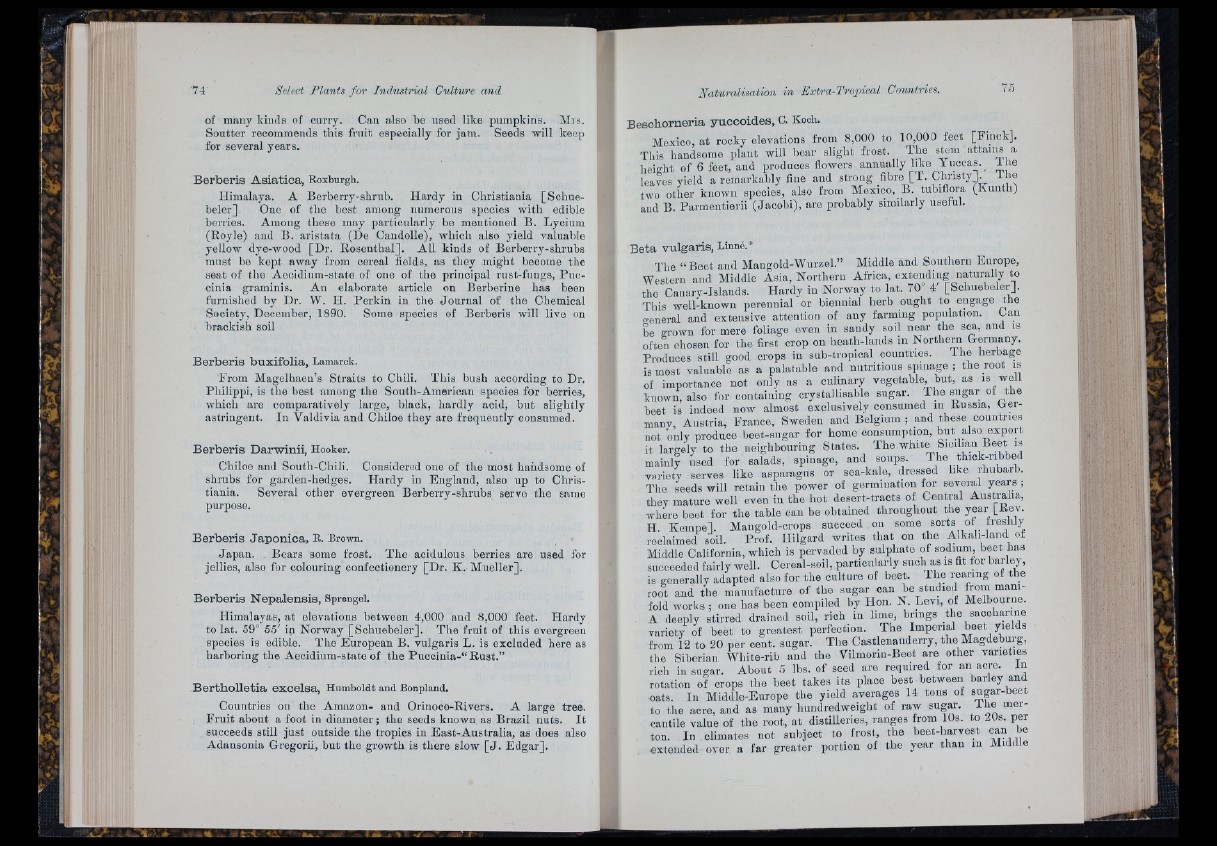
Select ria n ts fo r Industrial Culture and
of many kinds of curry. Can also be used like pumpkins. Mrs.
Soutter recommends this fniit especially for jam. Seeds will keep
for several years.
B e rb e ris A s ia tic a , Roxburgh.
Himalaya. A Berberry-shrnb. Hardy in Christiania [Schuebeler].
One of the best among numerous species with edible
berries. Among tliose may particularly be mentioned B. Lyeium
(Royle) aud B. aristata (De Candolle), whicli also yield valualile
yellow dye-wood [Dr. Rosenthal]. All kinds of Berberry-shrubs
must be kept away from cereal fields, as they might become the
seat of the Aecidinm-state of one of the principal rust-fnngs, Pnc-
cinia graminis. An elaborate article on Berberine has been
furnished by Dr. W. H. Perkin in tiie Journal of the Chemical
Society, December, 1890. Some species of Berberis will live on
brackish soil
B e rb e ris b u x ifo lia , Lamarck.
Prom Magelhaen’s Straits to Chili. This bush according to Dr.
Pliilippi, is tlie best among tlie South-American species for berries,
whicli are comparatively large, black, hardly acid, but slightly
astringent. In Valdivia and Cliiloe they are frequently consumed.
B e rb e ris D a rw in ii, Hooker.
Chiloe and South-Chili. Considered one of the most handsome of
shrubs for garden-hedges. Hardy in England, also up to Christiania.
Several otlier evergreen Berberry-shrubs serve the same
purpose.
B e rb e ris J a p ó n ic a , R. Brown.
Japan. Bears some frost. The acidulous berries are used for
jellies, also for colouring confectionery [Dr. K. Mueller].
B e rb e ris N e p a le n s is , Sprengel.
Himalayas, at elevations between 4,000 and 8,000 feet. Hardy
to lat. 59° 55' in Norway [Schuebeler]. The fruit of this evergreen
species is edible. The European B. vulgaris L. is excluded here as
harboring the Aecidinm-state of the Puccinia-“ Rust.”
B e rth oU e tia e x c e ls a , Humboldt and Bonpland.
Countries on the Amazon- and Oriuoco-Rivers. A large tree.
F ru it about a foot in diameter; the seeds known as Brazil nuts. I t
succeeds still just outside the tropics in East-Australia, as does also
Adansonia Gregorii, but the growth is there slow [ J . Edgar],
1 2 SH
B e sch o rn e ria y u c c o id e s , C. Koch.
Mexico, a t rocky elevations from 8,000 to 10,000 feet [Finck].
This handsome plant will boar slight frost. The stem attains a
heic-ht of 6 feet, and produces flowers annually like Yuccas._ I le
leaves yield a remarkably fine and strong fibre [T . Christy]. The
two other known species, also from Mexico, B. tubiflora (Kunth)
and B. Parmentierii (Jacobi), are probably similarly useful.
B e ta v u lg a ris , Linné.*
The “ Beet and Mangold-Wurzel.” Middle and Southern Europe,
Western and Middle Asia, Northern Africa, cxteiidiug naturally to
the Canary-Islands. Hardy in Norway to lat. 70 4 [Schuebeler].
This well-known perennial or biennial lierb ought to engage the
o-eneral and extensive attention of any farming population. Can
be o-rown for mere foliage oven in sandy soil near the sea, and is
often chosen for the first crop on heath-lands in Northern Germany.
Produces still good crops in sub-tropical countries. I h e herbage
is most valuable as a palatable and nutritious spmage ; the root is
of importance not only as a culinary vegetable but, as is well
known, also for containing crystallisable sugar. The sugar of the
beet is indeed now almost exclusively consumed in Russia, C-er-
many, Austria, France, Sweden and Belgium ; and these countries
not only produce beet-sugar for home consumption, bu t also export
it largely to the neighbouring States. The white Sicilian Beet is
mainly used for salads, spinage, and soups. I ho thick-nbbed
variety serves like asparagus or sea-kale, dressed like rhubarb.
The seeds will retain the power of germination for several years ;
they mature well even in the hot desert-tracts of Central Australia,
where beet for tlie table can be obtained througliout tlie year [Rev.
H. Kempe], Maiigold-crops succeed on some sorts of Besiily
reclaimed soil. Prof. Hilgard writes th a t on the Alkali-laiid of
Middle California, wliich is pervaded by sulphate of sodmm, beet has
succeeded fairly well. Cereal-soil, particularly such as is fit for barley,
is generally adapted also for the culture of beet. Ih e rearing of the
root and the manufacture of the sugar can he studied from manifold
works ; one has been compiled by Hon. N. Levi, of Melbourne.
A deeply stirred drained soil, rich in lime, brings the sacoharme
variety of beet to greatest perfection. The Imperial beet yields
from 12 to 20 per cent, sugar. The Castlenauderry, the Magdeburg,
the Siberian Wliite-rib and the Vilmorm-Beet are otlier varieties
rich in sugar. About 5 lbs. of seed are required for an acre, in
rotation of crops the beet takes its place best between barley and
oats. In Middle-Europe the yield averages 14 tons of sugar-beet
to the acre, and as many hundredweight of raw sugar. The mercantile
value of the root, at distilleries, ranges from 10s. to 20s. per
ton. In climates not subject to frost, the beet-harvest can be
extended over a far greater portion of the year than in Middle
fr '
1 fr. '
Ifr lifr'
'fr frkl.
fr. .li-: